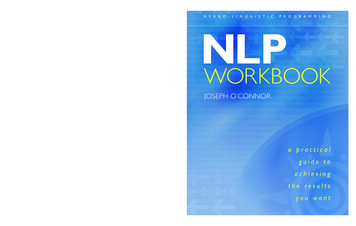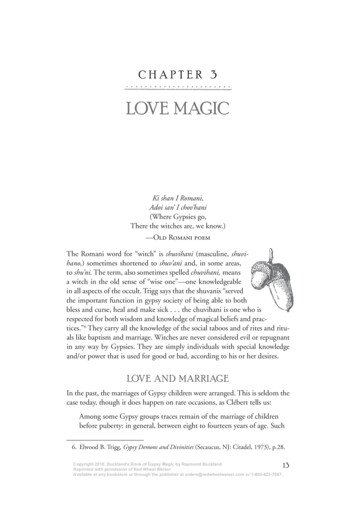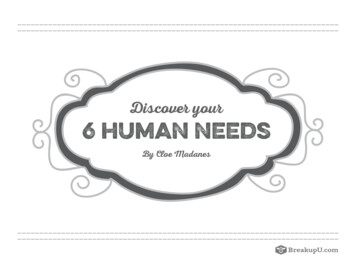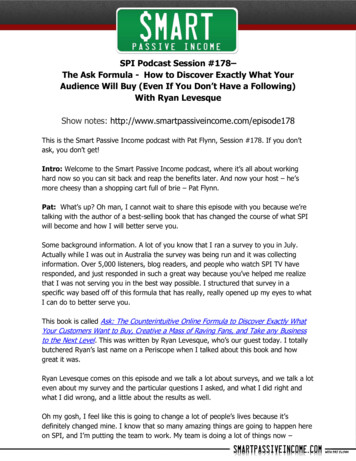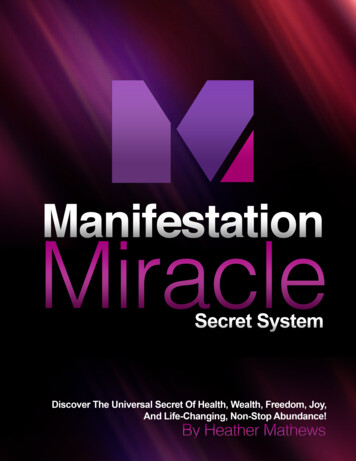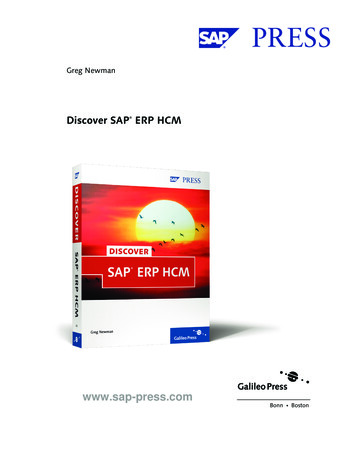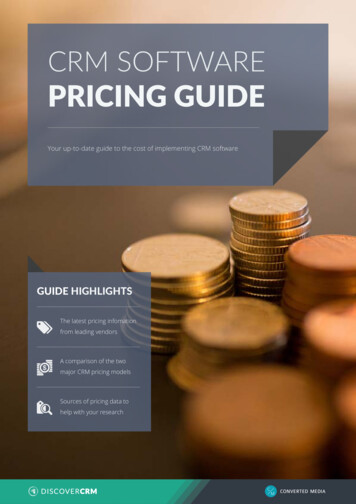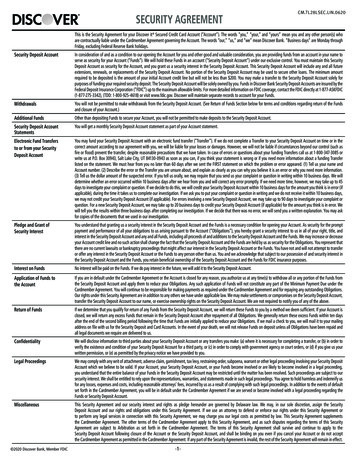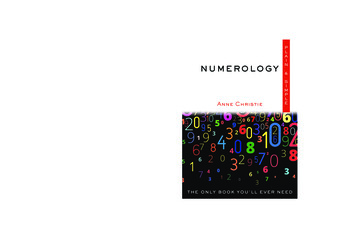
Transcription
Magical and OccultPower of Numbersorder to understand themselves and to unravel the mysteries of thefuture in much the same way as they have used astrology. Just asthe signs and symbols of astrology contain a universal language,numbers as well embody their own unique meaning. Everythingfrom the divine to the mundane hides in numbers, and a personwho understands the language of numbers can unlock theirenergies and discover their secrets.You’ll find many interesting topics to explore, including your Personality number Heart numberDestiny number Relationship number Short-term forecastsName numberOnce you master the simple principles of the numerology method,you’ll be able to plan your days, predict your future, and even findthe most suitable mate. Numerology Plain & Simple is an accessibleand user-friendly guide for people interested in divination systems,personality types, and unlocking the secrets of the universe.NUMEROLOGYAnne ChristiePLAIN&SIMPLEPLAIN & SIMPLEUsing numerology to learn more about yourself and your futuredoesn’t require any psychic abilities, mathematical skills, or even anyspecial equipment—all you need to know is how to add! In this book,you’ll learn the basics of how to use numbers to explain your life.NUM ER O L O G YFor many thousands of years, people have used numerology inChristieDiscover thewww.redwheelweiser.comISBN: 978-1-57174-759-4U.S. 14.95THE ONLY BOOK YOU’LL EVER NEED
Copyright 2005, 2016by Anne ChristieAll rights reserved. No part of this publication may be reproduced or transmitted in any form orby any means, electronic or mechanical, including photocopying, recording, orby any information storage and retrieval system, without permission in writing fromHampton Roads Publishing, Inc. Reviewers may quote brief passages.Previously published in 2005 as Simply Numerologyby Zambezi Publishing Limited, Devon, UK.Cover design by Jim WarnerCover illustration iunewind / ShutterstockInterior design by Kathryn Sky-PeckHampton Roads Publishing Company, Inc.Charlottesville, VA 22906Distributed by Red Wheel/Weiser, llcwww.redwheelweiser.comSign up for our newsletter and special offers by going towww.redwheelweiser.com/newsletter/The names used in this book as examples for the purposes of explaining the numerology method arerandomly fabricated and do not represent any real person living or dead.ISBN: 978-1-57174-759-4Library of Congress Control Number: 2016953229Printed in CanadaMAR10 9 8 7 6 5 4 3 2 1
AboutNumerologyINTRODUCTION
People have studied numerology for many thousands of yearsin order to understand themselves and to unravel the mys-teries of the future in much the same way as they have usedastrology. Just as the signs and symbols of astrology contain auniversal language, numbers as well embody their own uniqueesoteric knowledge. Many early civilizations, such as the ancientEgyptians, the Hebrews, the Chaldeans, and the Hindus studiednumbers as a science. Many people today believe that everythingfrom the divine to the mundane hides in numbers, and that a person who understands the language of numbers can unlock theirenergies can discover their secrets .Numerology has always had mystical and spiritual significance. The two main sources of our current systems of numerology are the Greek philosopher, mathematician, and astrologer,Pythagoras, and the Hebrew Kabbalah.Sometimes called the Father of Numerology,Pythagoras (5th century BC) spent a lifetimestudying numbers. He was convinced that numbers had mystical properties, and he defined thesystem of numerical classification that we stilluse today. In math, every schoolchild learns thePythagorean Theorem, a fundamental propertyof geometry he formulated. Pythagoras believedthat numbers contained the secrets of the entireuniverse; some of his ideas postulated that themost powerful (masculine) numbers were thePythagoras, the Father of Numerology2NUMEROlOGY PlAIN AND SIMPlE
odd ones, while the even numbers were less powerful (and feminine). This universal concept also shows up in the I Ching, butPythagoras would not have had contact with Chinese thinkers inthose ancient days .Moving forward in time to the early 16th century, we find thephilosopher Henry Agrippa, who devised a system that relatesman to numbers. In the 18th century, Count Cagliostro inventedhis own system of numerology that gave prophetic readings. Boththese men based their systems on the ancient Kabbalistic system of gematria—a numerical system that was both mystic andrevelatory .Other students of the occult believed that when one transcribed the letters of a person’s name into numbers, the resultswere similar to an astrological chart. One of the most famousnumerologists of the 19th century was Count Louis Hamon, whowe know by his assumed name of Cheiro. He was an astrologer,numerologist, and palmist; his sobriquet, “Cheiro,” derives fromthe word cheiromancy, meaning “palmistry.”Many famous and influential clients consulted Cheiro, including King Edward VII.This plain and simple book is meant to introduce you to thefascinating study of numerology, and give you some tools tounderstand yourself and others, and perhaps even have a peakat your destiny!INTRODUcTION3
A BriefHistoryof Numbers1
Numbers are fascinating, with an ancient and rich history.Here is a very brief overview of that history, and how num-bers have come to be used in numerology.Language and NumbersThe earliest form of numbers came from Babylon andMesopotamia, the fertile area around the Tigris and Euphratesrivers, the area which encompasses the country we now callIraq. This area is often referred to the “cradle of civilization,” forit is here that complex urban centers sprang up. Up to that time,humans lived a simple hunting or farming existence and they hadno need to keep records. Cities brought the first forms of business and the subsequent need to account for animals that peoplebought and sold, and the need to account for the purchase andsale of grain and other goods. The earliest writing in this areawas called cuneiform, dating back to 3500 BC; it was basically anenhanced bookkeeping system.Egyptian writing (circa 3000 BC) and Chinese writing (circa1500 BC) derived from pictograms (pictures) that eventuallybecame connected to sounds or words. As time went by, thesounds and word meanings evolved; they gradually lost their pictorial form and drifted into looking like early forms of writing.Letters as NumbersHebrew and Ancient GreekAn early type of writing that depended upon an actual alphabetwas Hebrew. This is a language that, like most, has also gone6NUMEROlOGY PlAIN AND SIMPlE
through various incarnations over the millennia; however, it hasnot changed as much as many other forms of language. Alephis still aleph and bet is still bet—although even within modernmemory, there are people who have pronounced bet as beth oreven base.The Hebrews didn’t have a separate number system, so theysimply used the letters of the alphabet as numbers, such asa 1 b 2 g 3 d 4The Hebrew alphabet only contains 22 characters, so numericvalues were calculated by combined letters. This combinationmethod was also true of the Greek system of numbers (each letter of the alphabet has a numerical value) and it is true of Romannumerals as well (and we still find Roman numerals in use today).The ancient Greeks used a system and alphabet similar to theHebrew alphabet; here are a few letters for comparison.HebrewGreekaAlphaAlephBetbdLamed lDaledαβDelta δBetaLambdaλOut of the Hebrew tradition grew the mystical Kabbalah, andits central symbol, the Kabbalist Tree of Life, which representsthe emanation of the universe. Numbers were very important tothe Kabbalists, and they used the Hebrew alphabet to enumerate each stage of development on the Tree of Life. Each of theseA BRIEF HISTORY OF NUMBERS7
numbered emanations is called a Sephira, and they are numberedone (Alepha) to ten (Yod y ). Each number is thought to expressthe vibration of its Sephira.132546879The Kabbalistic Tree of Life10One of the earliest forms of numerology, called gematria,derives from the mystical Kabbalah. Gematria is a method ofinterpreting mystical scripture by computing the numerical valueof words (based on the number correspondences of the Hebrewalphabet) and then finding corresponding words with the samevalue. In gematria, two words are mystically equivalent if they addup to the same number. For example, the Hebrew words for “love”and “one” both have the numerical value of 13; this mystical connection thus reinforces the belief that “the One God is Love.”The numerology of Kabbalah is a fascinating separate study,but it is not a system widely used by modern numerologists.8NUMEROlOGY PlAIN AND SIMPlE
The RomansThe Romans also used letters as numbers and we know thesetoday as “Roman numerals.” Here are a few examples:M C IXVIIIM 1,000C 100L 50X 10V 5I 1IX 10 minus 1 (left), therefore 9XI 10 plus 1 (right), therefore 11IV 5 minus 1, therefore 4VI 5 plus 1, therefore 6As you can see, these alphabet number systems were cumbersome, and none of them included a zero. The number systemswere useful for counting, but true mathematics was not born untilthe time of Pythagoras.True NumbersThe number system that we use in the West today is called theArabic system or Arabic numbers. This system actually came fromIndia, but Persian and Arab traders used it because it was simple touse, it worked for math, and it was universal. It wasn’t attached toany particular nation or alphabet, as were the Roman, Greek, andHebrew systems, so it had no national or religious connotations.A BRIEF HISTORY OF NUMBERS9
The BasicMethod ofNumerology2
The numerical system we use today, the Arabic system, is a“base 10” alphabet of numbers. That means we count from 0to 9, and then begin a second set from 10 to 19, and then 20 to29, and so forth.The practice of numerology is based on the Pythagorean system of 1 through 9 (the concept of “zero” was not even postulateduntil 1,000 years after Pythagoras!) This Pythagorean system isalso know as the Western system of numerology. It is the easiestnumerology method to learn and the easiest to work with.Your Basic Tool KitUsing numbers together with the table of keywords on page 15,you will be able to look at your own personal character and studythe temperament of others. You need no special talent or psychic skill, and you do not have to be a mathematician to understand it, because there are no formulas or equations to memorize.Numerology is fun, simple, yet scientific, so it will enable you topinpoint areas that you can work on for your personal growth.The Name NumberOld time numerologists used to insist that, when you look intothe vibrations of your name, you should use the name that is onyour birth certificate. Many modern numerologists consider thisan outdated idea, unless you continue to use your birth namethroughout your life. People change their names for many reasons—by marriage, through gender transformation, or by whim.12NUMEROlOGY PlAIN AND SIMPlE
Some people use one name among close friends and anotherin business (a pet name such as Niki instead of the more formalNicole), some people use a pen name for their creative work,and some people have permanently adopted a shortened version of their birth name (such as Kate) and never go by its original(Kathleen, or Katherine). The name you use today is who you areat this moment in time, and that is the name you should workwith numerologically to determine your name number.Having said that, however, you might find it interesting to tryout the system using your birth name and any other names youhave used in the course of your lifetime. You will be able to seewhether these name changes have affected your behavior orcharacter at different times of your life or under different circumstances, such as before or after marriage.The chart below is the numerology table we will be workingwith. You may wish to copy it down so that it is easy to refer to,until you become familiar with it and have it memorized.123456789ABCDEFGHIJKLMNOPQRSTUVWXYZNow let’s get to work!In this book, I have used an imaginary person called JamesRobert Pearson* and we will use that name in our calculationexamples.*I’ve randomly made this name up, and it is not meant to represent any real person living or dead.THE BASIc METHOD OF NUMEROlOGY13
Start by finding the numbers that correspond to each letter inyour name, and make a note of it. You will end up with a string ofnumbers like this:Jam esRobertP ears11419625927191 6 555o nNow shrink the numbers down to a single digit by adding thenumbers together. Just study the following examples and you willsoon get the idea. The first thing we did above was to find thenumbers that correspond to every letter in James’ name.Now add all the numbers together to see what they come to.You can do it in one go, or a piece at a time. You’ll come up withthe same results.Here are both methods:JamesRobertPearson1, 1, 4, 5, 1 9, 6, 2, 5, 9, 2 7, 5, 1, 9, 1, 6, 5 79James: 1 1 4 5 1 12Robert: 9 6 2 5 9 2 33Pearson: 7 5 1 9 1 6 5 34sum 79Now we reduce this number by adding 7 9 to make 16.Then we reduce the number again by adding 1 6 to make 7.Keep reducing your sums until you come up with a single digit.Easy, right?Thus, James Robert Pearson’s name number is 7.14NUMEROlOGY PlAIN AND SIMPlE
Using Familiar Name, or NicknameLet us assume that James Robert Pearson prefers to call himselfJim Pearson and see what happens:Jim: 1 9 4 5Pearson: 7 5 1 9 1 6 5 34sum 39Now we add 3 9 to make 12.Then 1 2 to make 3.In this method, Jim Pearson’s name number is 3.Keywords for NumerologyThe Energy of Numbers and Dynamic ForcesMasculine and feminine numbers (first suggested by Pythagoras)do not have a sexual association. Like ying and yang, they relateto the dynamic forces that govern the energy of number.NumberE
NUMEROLOGY P L A I N & S Ifuture in much the same way as they have used astrology. Just as M P L E Christie NUMEROLOGY PLAIN & SIMPLE www.redwheelweiser.com ISBN: 978-1-57174-759-4 U.S. 14.95 Discover the Magical and Occult Power of Numbers For many thousands of years, people have used numerology in
